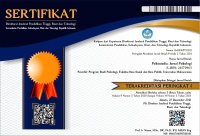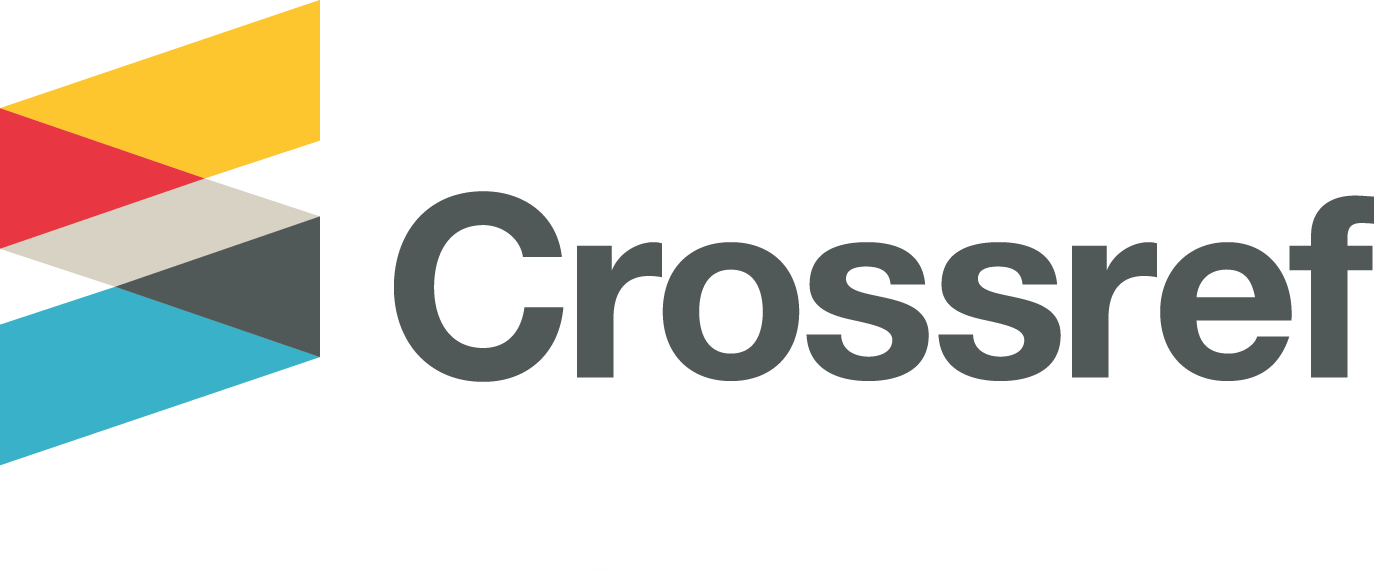Exploratory Factor Analysis of Teacher’s Engagement Scale for Early Child Teacher
Abstract
Teacher engagement is an important factor for teachers to have, which can influence student engagement and student success in the educational process at school. Teacher engagement in this research comes from the student engagement construct, including definitions of behavioral engagement, emotional engagement, and cognitive engagement. This research aims to explore the initial development of the Teacher Engagement Scale specifically for early childhood teachers. This research uses exploratory factor analysis (EFA) method, to see whether the Teacher Engagement Scale items can reflect the construct of teacher engagement. The participants in this research were early childhood teachers with a minimum of 1 year teaching experience. There would be around 230 -245 participants to be involved in this research. The measurement method uses self-report with 4 Likert scales. There are 23 question items in this questionnaire. EFA in this research produces two factors that can explain the construct of teacher engagement. EFA also found that the items from the emotional dimension may not represent that dimension.
Teacher engagement atau keterlibatan guru menjadi salah satu faktor penting untuk dimiliki guru, yang dapat mempengaruhi student engagement dan keberhasilan siswa dalam proses pendidikannya di sekolah. Teacher engagement dalam penelitian ini berasal dari konstruk student engagement, meliputi definisi dari behavioral engagement, emotional engagement, serta cognitive engagement. Penelitian ini bertujuan untuk mengeksplorasi pengembangan awal dari Teacher Engagement Scale yang dikhususkan untuk guru anak usia dini. Metode penelitian ini menggunakan analisis faktor eksploratori atau Exploratory Factor Analysis (EFA), sehingga dapat diketahui apakah aitem-aitem Teacher Engagement Scale tersebut dapat mencerminkan konstruk teacher engagement. Partisipan dari penelitian ini adalah guru anak usia dini dengan lama mengajar minimal 1 tahun dan berjumlah sekitar 230 -245 orang. Metode pengukuran menggunakan self-report dengan 4 skala Likert. Total aitem pertanyaan dalam kuisioner ini berjumlah 23 buah. EFA pada penelitan ini menghasilkan dua faktor yang dapat menjelaskan konstruk dari teacher engagement tersebut. EFA juga menemukan bahwa aitem-aitem dari dimensi emosional kemungkinan belum mewakili dimensi tersebut.
Keywords
Full Text:
FULL TEXTReferences
Abdal, N. M., Sulaiman, D. R. A., & Setialaksana, W. (2023). Pengembangan Instrumen Efikasi Diri dalam Matematika: Studi Validasi dengan Analisis Faktor Eksploratori. Jurnal MediaTIK, 6(2), 109. https://doi.org/10.26858/jmtik.v6i2.47007
Caron, P. O. (2019). Minimum average partial correlation and parallel analysis: The influence of oblique structures. Communications in Statistics: Simulation and Computation, 48(7), 2110–2117. https://doi.org/10.1080/03610918.2018.1433843
Erlanggashani, C., Suarka, F. M., & Pertiwi, P. R. (2022). Faktor-Faktor yang menentukan terjadinya sistem promosi jabatan karyawan di masari villas and spa. Jurnal Kepariwisataan Dan Hospitalitas, 5(2), 102. https://doi.org/10.24843/jkh.2021.v05.i02.p07
Faturohman, N., & Gunawan, A. (2021). Tantangan Lembaga Pendidikan Dasar dalam Penyelenggaraan Pendidikan Pasca Pandemi COVID-19 di Kabupaten Serang. Geneologi PAI: Jurnal Pendidikan Agama Islam, 8(2), 433–442.
Fredricks, J. A., Blumenfeld, P. C., & Paris, A. H. (2004). School engagement: Potential of the concept, state of the evidence. Review of Educational Research, 74(1), 59–109. https://doi.org/10.3102/00346543074001059
Hair, J. F. J., Black, W. C., Babin, B. J., & Anderson, R. E. (2010). Multivariate Data Analysis Seventh Edition. Pearson Prentice Hall.
Hapsari, P. N. F., Rahmawati, A., & Jumiatmoko, J. (2020). Hubungan Antara Relasi Guru-Anak Dengan Kemampuan Keaksaraan Anak Usia 5-6 Tahun. Kumara Cendekia, 8(3), 253. https://doi.org/10.20961/kc.v8i3.42603
Hidayat, N. A. S. N., & Nisa, N. (2022). Tantangan Inovasi Pendidikan di Masa Pasca Pandemi. Jurnal Basicedu, 6(5), 9079–9086. https://jbasic.org/index.php/basicedu/article/view/3345
Izquierdo, I., Olea, J., & Abad, F. J. (2014). Exploratory factor analysis in validation studies: Uses and recommendations. Psicothema, 26(3), 395–400. https://doi.org/10.7334/psicothema2013.349
Jang, H., Reeve, J., & Deci, E. L. (2010). Engaging Students in Learning Activities: It is Not Autonomy Support or Structure but Autonomy Support and Structure. Journal of Educational Psychology, 102(3), 588–600. https://doi.org/10.1037/a0019682
Jennings, P. A., & Greenberg, M. T. (2009). The prosocial classroom: Teacher social and emotional competence in relation to student and classroom outcomes. Review of Educational Research, 79(1), 491–525. https://doi.org/10.3102/0034654308325693
Khusna, T., Akbarita, R., & Narendra, R. (2021). Perbandingan Principal Axis Factoring Dan Maximum Likelihood Dalam Menentukan Faktor Dominan Yang Mempengaruhi …. BAREKENG: Jurnal Ilmu …, 15(4), 785–796. https://ojs3.unpatti.ac.id/index.php/barekeng/article/view/3998%0Ahttps://ojs3.unpatti.ac.id/index.php/barekeng/article/download/3998/3585
Klassen, R. M., Perry, N. E., & Frenzel, A. C. (2012). Teachers’ relatedness with students: An underemphasized component of teachers’ basic psychological needs. Journal of Educational Psychology, 104(1), 150–165. https://doi.org/10.1037/a0026253
Klassen, R. M., Yerdelen, S., & Durksen, T. L. (2013). Measuring teacher engagement: Development of the engaged teachers scale (ets). Frontline Learning Research, 1(2), 33–52. https://doi.org/10.14786/flr.v1i2.44
Osborne, J. W. (2015). What is rotating in exploratory factor analysis? Practical Assessment, Research and Evaluation, 20(2), 1–7.
Pedler, M., Hudson, S., & Yeigh, T. (2020). The teachers’ role in student engagement: A review. Australian Journal of Teacher Education, 45(3), 48–62. https://doi.org/10.14221/ajte.2020v45n3.4
Sa’diyah, S. A., Reza, M., Widayanti, D., & Komalasari, D. (2022). Studi Komparatif Kompetensi Profesional Guru Paud Ditinjau Dari Latar Belakang Pendidikan. JP2KG AUD (Jurnal Pendidikan, Pengasuhan, Kesehatan Dan Gizi Anak Usia Dini), 3(1), 35–50. https://doi.org/10.26740/jp2kgaud.v3n1.35-50
Sasmoko, Indrianti, Y., Khan, A., Nurkamto, J., Harsoyo, Y., Mimba, N. P. S. H., Suryanti, & Goni, A. M. (2017). Construct theoretical: Indonesian teacher engagement index (ITEI). Man in India, 97(19), 91–97.
Shrestha, N. (2021). Factor Analysis as a Tool for Survey Analysis. American Journal of Applied Mathematics and Statistics, 9(1), 4–11. https://doi.org/10.12691/ajams-9-1-2
Taherdoost, H., Sahibuddin, S., & Jalaliyoon, N. (2022). Exploratory Factor Analysis; Concepts and Theory. Advances in Applied and Pure Mathematics, 27, 375–382.
Velicer, W. F., Eaton, C. A., & Fava, J. L. (2000). Construct Explication through Factor or Component Analysis: A Review and Evaluation of Alternative Procedures for Determining the Number of Factors or Components. In Problems and Solutions in Human Assessment: Honoring Douglas N. Jackson At Seventy (Issue May, pp. 41–71). https://doi.org/10.1007/978-1-4615-4397-8
Wang, M. Te, & Degol, J. (2014). Staying Engaged: Knowledge and Research Needs in Student Engagement. Child Dev Perspect., 8(3)(1), 137–143. https://doi.org/10.1111/cdep.12073.Staying
Wang, M. Te, & Eccles, J. S. (2012a). Adolescent Behavioral, Emotional, and Cognitive Engagement Trajectories in School and Their Differential Relations to Educational Success. Journal of Research on Adolescence, 22(1), 31–39. https://doi.org/10.1111/j.1532-7795.2011.00753.x
Wang, M. Te, & Eccles, J. S. (2012b). Social Support Matters: Longitudinal Effects of Social Support on Three Dimensions of School Engagement From Middle to High School. Child Development, 83(3), 877–895. https://doi.org/10.1111/j.1467-8624.2012.01745.x
Watkins, M. W. (2018). Exploratory Factor Analysis: A Guide to Best Practice. Journal of Black Psychology, 44(3), 219–246. https://doi.org/10.1177/0095798418771807
Williams, B., Onsman, A., & Brown, T. (2010). Exploratory factor analysis: A five-step guide for novices. Journal of Emergency Primary Health Care (JEPHC), 8(3), 1–13.
Willms, J. D. (2003). Student engagement at school: A sense of belonging and participation. OECD Retrieved from Www Pisa Oecd Org on March, 1–84. https://doi.org/10.1787/19963777
Wood, N. D., Akloubou Gnonhosou, D. C., & Bowling, J. W. (2015). Combining Parallel and Exploratory Factor Analysis in Identifying Relationship Scales in Secondary Data. Marriage and Family Review, 51(5), 385–395. https://doi.org/10.1080/01494929.2015.1059785
DOI: http://dx.doi.org/10.30872/psikostudia.v13i2.15253
Refbacks
- There are currently no refbacks.
Copyright (c) 2024 Cut Ira Dian Sari & Tulus Budi Sulistyo Radikun

This work is licensed under a Creative Commons Attribution-ShareAlike 4.0 International License.
Psikostudia: Jurnal Psikologi is indexed by :
PSIKOSTUDIA: Jurnal Psikologi Published by Faculty of Social and Political Siences, University of Mulawarman, Samarinda, East Kalimantan and This work is licensed under a Creative Commons Attribution-ShareAlike 4.0 International License.
_________________________________________
PSIKOSTUDIA: Jurnal Psikologi
Department of Psychology
Faculty of Social and Political Siences, University of Mulawarman
Jl. Muara Muntai Kampus Gn. Kelua Samarinda 75411
Phone: +62 813 35350368
E-Mail: psikostudia@fisip.unmul.ac.id




















